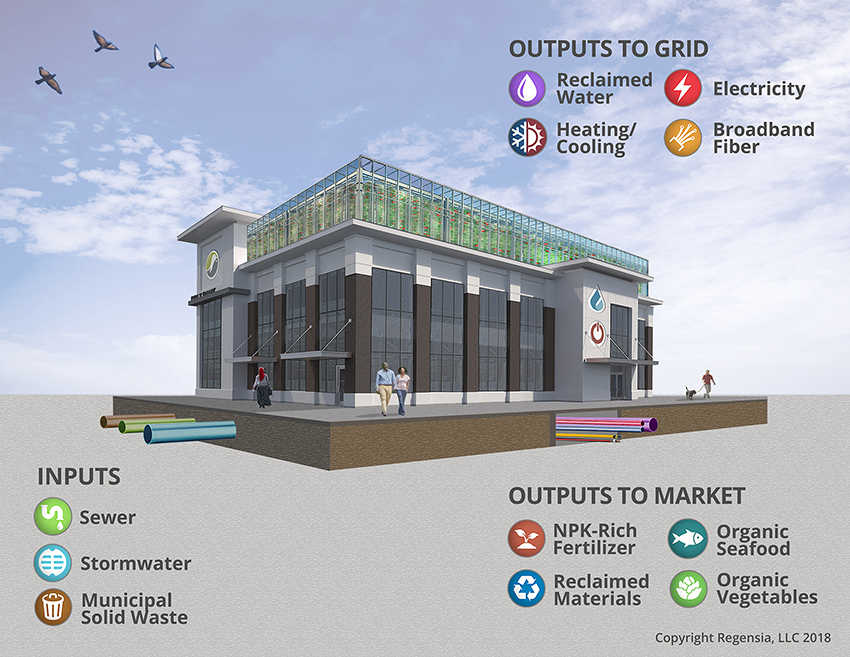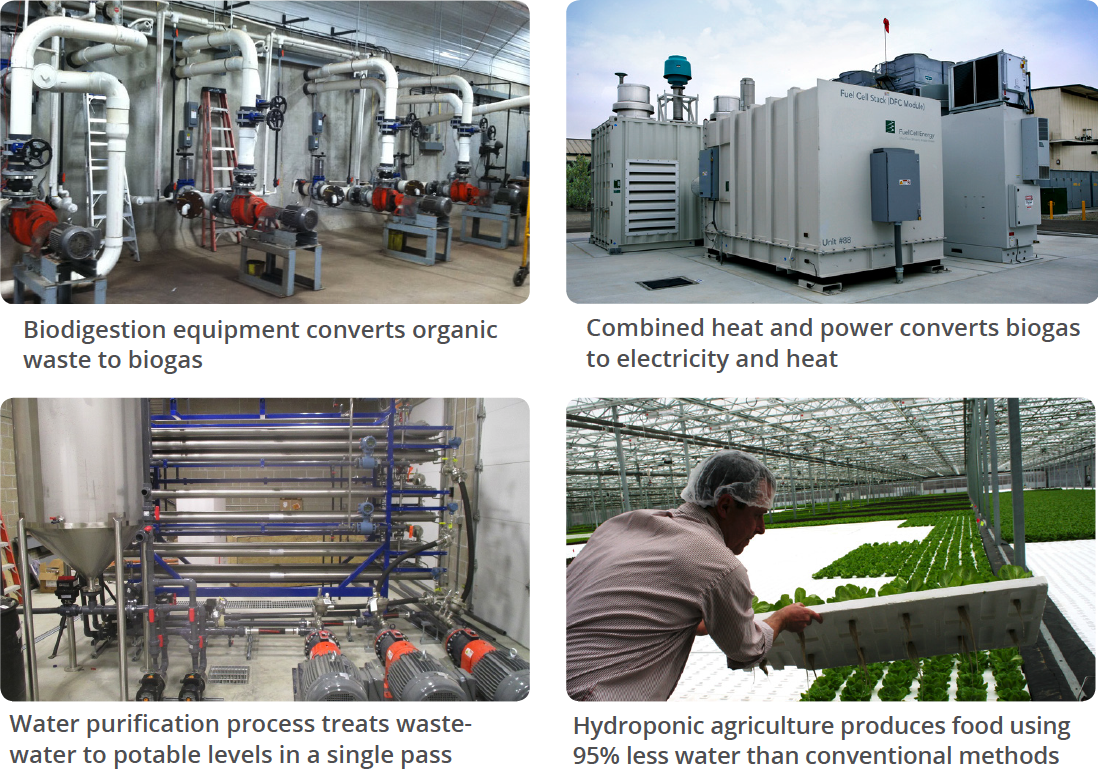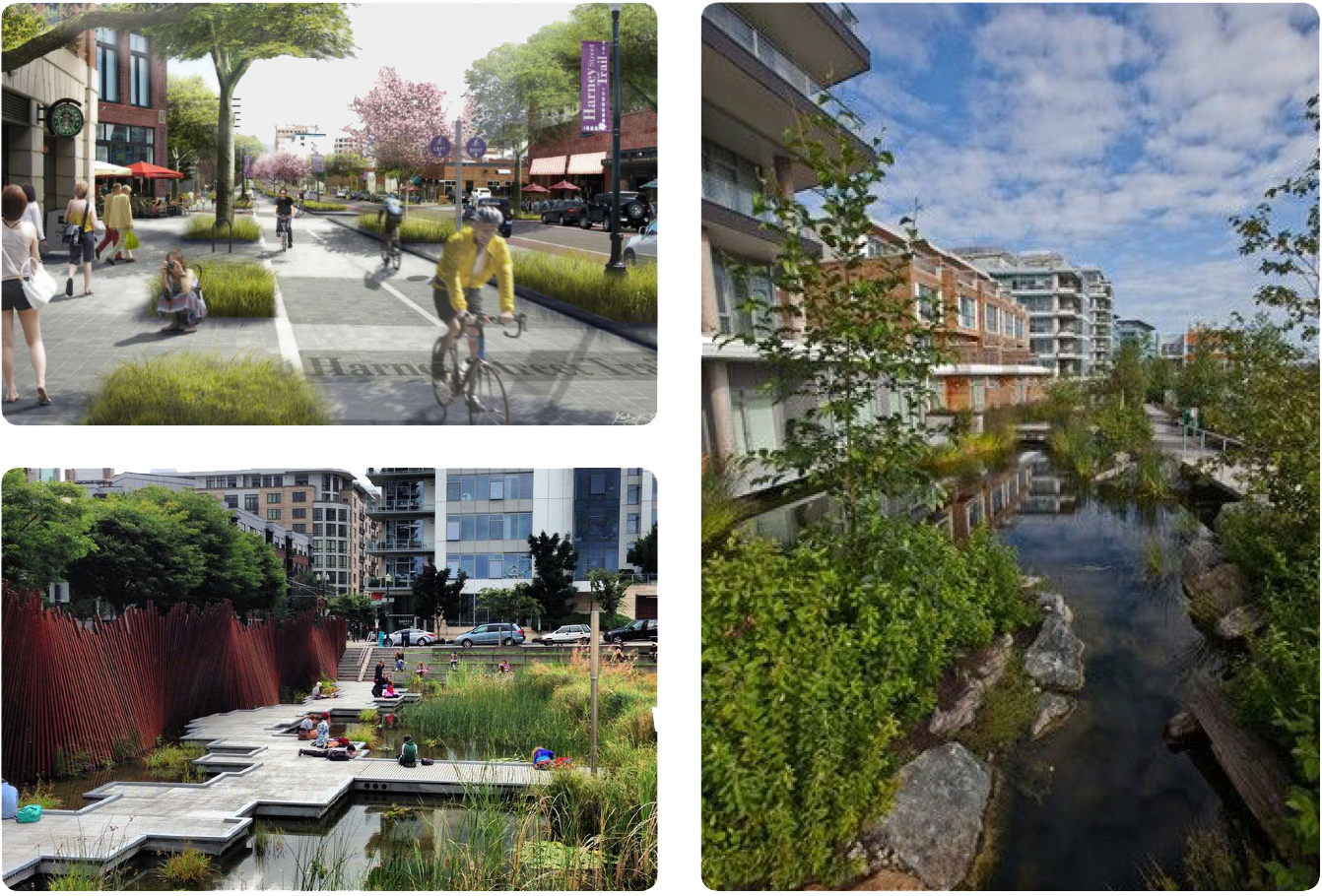The conventional urban development model has remained fundamentally unchanged for 100+ years. Energy, water, materials, and food are predominantly produced at centralized/industrial scales outside of urban centers and managed within linear ‘take, make, waste’ industrial processes that create inordinate amounts of waste and pollution. Regensia’s systems-based, circular, and district-scaled infrastructure solutions flip this conventional model on its head, illustrating how resources can be produced and managed locally to dramatically enhance urban resource productivity, resilience, health, and equity.
The Integrated Utility Hub
As an ideal regenerative urban strategy, Regensia designs and facilitates the development of Integrated Utility Hubs (IUH), next generation infrastructure solutions that function as a community’s metabolic engine. The IUH transforms municipal liabilities (solid and liquid waste) into valuable assets for local use: recycled potable water, renewable energies, nutrient-rich fertilizer, fresh food, and high purity reclaimed materials. Its core equipment is highly scalable and can be placed inside standard shipping containers to support ease of transport to remote regions of the world, or it can be scaled up to power major development projects in dense urban cores. The IUH represents a holistic and disruptive infrastructure business model by:
Stacking Functions. The IUH provides the function in one facility of multiple facilities traditionally at different locations, saving citywide costs and resource impacts associated with developing multiple single-function facilities.
Symbiotic Production Efficiencies. The IUH reduces internal production and operating costs through symbiotic processes. Every output in the Hub is an input for another part of the system, creating production efficiencies and resource/cost savings.
Managing Resources Hyper-Locally. The IUH enables localized and distributed resource production/management to occur within dense urban areas. This reduces resource transmittal impacts/costs and enhances city resilience were a disaster to strike by providing system redundancies.
Beyond its production capabilities, the IUH can also serve as an asset within the public realm, incorporating various community amenities such as food markets, offices, laboratories, classrooms, exhibition spaces, and recreation facilities.


The Integrated Utility Hub represents a paradigm shift in urban resource management and grid functionality. Review our Featured Projects to see the IUH modeled for different communities.
The Integrated Utility System
Recognizing that the Integrated Utility Hub requires connections to buildings and public spaces to power a regenerative community, Regensia designs Integrated Utility Systems (IUS). The IUS expands urban metabolic management to the district scale and captures additional value through systems integration. It incorporates a coordinated network of traditionally independent grid components as a unified district grid system. Elements such as heating and cooling, electricity, high speed broadband fiber, pneumatic waste collection, and water pipes (sanitary, supply, and stormwater) can be coordinated within a shared utility tunnel for ease of installation and maintenance.
Through higher levels of systems integration and district-based implementation, the IUS enables: (1) improved service delivery and reliability of utilities, (2) reduced systems-wide costs (capital and operating), (3) greater environmental performance, and (4) valuable new circular economic development opportunities. As a result, the IUS serves as a powerful foundation for community resilience and equitable prosperity, stabilizing resource access and costs for decades to come, and delivering aggressive sustainability goals far faster than building-by-building approaches as every connected building automatically becomes green.

Regenerative Placemaking
In addition to its integrated grid solutions, Regensia contributes to designing land use plans and neighborhood places that effectively interface the Integrated Utility Hub/System (IUH/S) with the public realm, expanding ecological connection, capacity, and function. Our planning services include support of:
Biophilic Infrastructure. Siting and design of biophilic green spaces that biologically manage stormwater, restore soil health, produce food, enhance biodiversity, and support public recreation.
Integrated Streets. Design of safe, beautiful, and multi-functional streets that support IUS infrastructure, multi-modal transit systems, stormwater retention, and public amenities.
High-Performance Buildings. High-performance building designs that contribute to regenerative city performance, including Living Buildings, Passive House, Energy Star, and LEED rating systems.



Comments are closed.